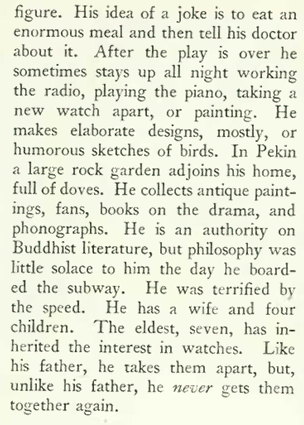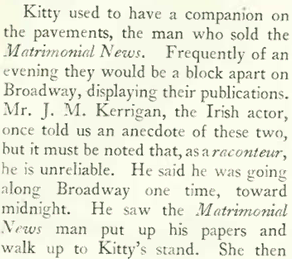When the fifth anniversary issue of The New Yorker hit the newsstands in February 1930, the magazine was also setting down another milestone: its first-ever publication of a James Thurber cartoon* (*see comment section).

Inserted into the top corner of page 25 (next to a short fiction piece by Emily Hahn), was Thurber’s first installment of his spoof on newspaper pet columns titled “Our Pet Department.”
Seeming a bit quizzical about his debut as a cartoonist, in February 1930 Thurber wrote to his friend Minnette Fritts Proctor (for whom he held lifelong romantic yearnings) that his drawings were “now coming into a strange sort of acclaim… The New Yorker is going to run a series of my animal pictures…and a concern wants me to do ads for it. Imagine!…I’m enclosing a few (pictures), which you can throw away. They’ll alarm you.”

Animals of all sorts would pop up in Thurber’s cartoons throughout the 1930s…

…and his famous dogs would make frequent appearances, including on their own cover in 1946 to coincide with that year’s Westminster Kennel Club Dog Show…
Office mate, co-author and friend E.B. White, on the other hand, assumed his usual duty of marking the magazine’s anniversary in “Notes and Comment”…

…and contemplated his own magazine’s contributions to the advancement of civilization…
…and as E.B. White continued his tradition of marking the magazine’s anniversary, so too did Rea Irvin continue to mark the passage of time with a tip of the hat from Eustace Tilley…
…and most prominently The New Yorker marked each anniversary with a repeat of the original Rea Irvin cover (later with some slight alterations), a tradition that continued unbroken until 1994, when a series of parodied versions of Eustace Tilley began to appear on the cover. The classic Tilley cover reappeared in the 2000s and ran frequently during that decade, but sadly made its last appearance in 2011 (see below covers from the first issue and anniversary covers from 2011 and 2019). I hope to see the Irvin cover return next year, and most certainly for the 100th anniversary in 2025. You can read more about cover’s history in Michael Maslin’s indispensable Ink Spill.
* * *
Drama Queen
Chinese opera star Mei Lanfang (1894-1961) was known as “Queen of Peking Opera” for his graceful stage portrayals of young and middle-aged women. Considered one of China’s greatest “Dan” performers (Dan is the general name for female roles), Mei had many admirers outside of China including Charlie Chaplin, Mary Pickford and Douglas Fairbanks, who welcomed Mei to Hollywood when he toured the U.S. in 1930. The New Yorker paid Mei a visit during his stay at the Plaza Hotel in Manhattan, recounted in these excerpts from “The Talk of the Town”…


* * *
A Kitty With Claws
“The Talk of the Town” also featured Kitty Marion (1871-1944) in a mini-profile. The German-born Marion moved to London at age 15, where she gained some prominence as a music hall singer. She found greater fame, however, as an activist, first standing up for the rights of fellow women performers and later crusading for voting rights. In response to attacks on women protestors by police officers, Marion embraced militant activism, throwing bricks through the windows of offices and handling a number of arson and bombing attacks that were intended to harm property, not people. Arrested numerous times (and enduring 232 force-feedings while on hunger strikes) she emigrated to the U.S. after World War I and joined forces with birth control advocate Margaret Sanger. The New Yorker takes it from there…

* * *
Going Deep With Noguchi
It’s hard to imagine modern decor without the influence of Isamu Noguchi, but before he inspired everything from coffee tables to lamps, he was a noted sculptor, and in 1930 he was best known for his portrait busts. New Yorker art critic Murdock Pemberton observed:


* * *
From Our Advertisers
The makers of Pond’s Cold Cream continued to roll out endorsements from society figures, including a “Mrs. John Davis Lodge” (Francesca Bragiotti), described in this advertisement as possessing “starry wide dark eyes, hair golden as Melisande’s, and tea-rose skin”…
…for reference, Francesca Bragiotti’s wedding portrait, as featured in Vogue magazine, 1929…
…Doubleday Doran targeted the appropriate audience for its publication of The Second New Yorker Album, with cover illustration by Peter Arno…
…and we have another lovely Camel ad from illustrator Carl “Eric” Erickson, who conjured up more Continental imagery as an inducement to take up a bad habit…
…in a recent post we looked at Don Dickerman, who operated themed restaurants in Greenwich Village. In the Feb. 22 issue he promoted his four restaurants in a series of ads (illustrated by Dickerman himself) that ran on four consecutive pages (72-75)…
…and Barbara Shermund illustrated this ad for Frigidare…
…Peck & Peck touted the “mannish lines” of its “Hillbilly” suits…
…no doubt influenced by trendsetters like Marlene Dietrich.
…and lest we forget that it’s 1930, a “Cowboys and Indians” mentality was rife in the advertising business, as seen in this ad from Mendel Trunx, proud of 20th century progress (“we’ve come a long way…”) and yet…well, read on…
…the mentality was still alive and well 30 years later, as seen in this ad from 1962…
…and coincidently, in the same issue we have this scene illustrated by Peter Arno mixing “Redskins” and luggage, in this case, a matron who means to summon the aid of a “red cap” baggage handler…
…other cartoons included this dramatic scene courtesy William Crawford Galbraith…
…a rustic, slightly naughty woodcut by John Held Jr…
…a peek at fashion trends by Helen Hokinson…
…a look at social mores…from Alan Dunn…
…and Alice Harvey…
…and we end with Barbara Shermund, and a moment of art appreciation…
Next Time: Famous Friends…

















































































































































